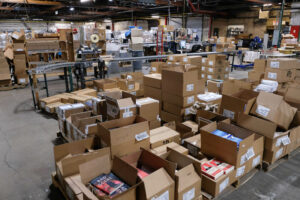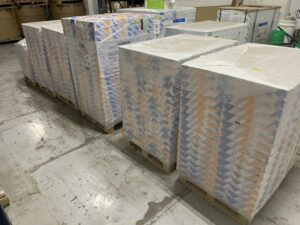PUBLISHED JANUARY/FEBRUARY 2022
by
Deb Vanasse, Reporter,
IBPA Independent magazine --

Deb Vanasse
Publishers are facing offset print run delays, lengthy turnaround times for print-on-demand orders, cost increases, and other obstacles—but they are drawing on their characteristic agility and ingenuity to survive.
Article Synopsis:
- COVID-19 was a catalyst for the current supply chain issues, but the origins of the problem run deeper.
- Effects of the supply chain crisis include increased print costs, and paper, cloth, and glue shortages.
- To combat the issues, indie publishers are planning further out, shifting deadlines and processes, prioritizing people and relationships, repurposing and remarketing existing inventory, and more.
When the supply chain works as it’s supposed to, publishers take it for granted. Send a project off to the printer, and the printer uses resources on hand to turn it around in a timely manner.
Not anymore. With supply chain disruptions, publishers are facing offset print run delays, lengthy turnaround times for print-on-demand orders, cost increases, and related obstacles. Even so, publishers and printers are meeting the challenge head-on, drawing on their characteristic agility and ingenuity. Though there’s undoubtedly some nostalgia for how smoothly things used to run, there’s also hope for the future, even if means some long-term adjustments.
The Weakest Links
It’s tempting to blame the supply chain crunch on COVID-19, but the problem’s origins run deeper than the pandemic. “COVID-19 restrictions triggered and exposed the vulnerabilities of a system that is 100% global-dependent,” says Adrianne Ford, market manager at Unity House Publishing and associate professor at the University of St. Mary, where she teaches operations management.
As Ford explains, the migration from print to digital in recent decades resulted in downsizing at every link in the printing supply chain, from lumber to ink. At the same time, operations became both increasingly globalized and increasingly disjointed. “Couple the decline of print with the fact of globalization and you have an industry that wasn’t prepared or equipped to handle increased demand,” she says.
Increased demand is exactly what happened when the pandemic hit. “People started reading again,” Ford says. “[They] began ordering from a system that had long ago scaled back to accommodate a world that had adjusted to technology and no longer revolved around print.”
Pandemic-driven scale-backs in the labor force exacerbated the problem. “Globalization worked until these vulnerabilities were exposed,” Ford says. “The primary weakness is we don’t have a USbased infrastructure to support end-to-end US-based manufacturing on a dime. We have a backlog of shipping items that are being finally released, but the real issue is that publishing is almost entirely dependent upon international raw materials and production.”

Phil Bevis
publisher Phil Bevis first noticed weak links in the supply chain over a year ago. From its origins as a publisher and printer of letterpress limited editions, Chatwin had made a large and unexpected expansion in 2018, when the company acquired its own full color printing shop and bindery. Ever since, Bevis has been printing for other publishers in addition to printing books for Chatwin’s own list.
In the fall of 2020, the printing end of the business was “slammed” with outside jobs, running its single digital press 90 to 100 hours a week in order to keep up. “We were so busy I didn’t have time to think about why and just assumed it was because of printers being shut down by COVID-19,” Bevis says. “In retrospect, we were getting work because of actual capacity problems.”
 IPG Ink’s manufacturing center.
IPG Ink’s manufacturing center.
By March, Chatwin’s paper suppliers were warning of shortages. “For environmental and other reasons, we only use paper from US mills, so we do not encounter the direct challenges other folks face who use offshore suppliers,” Bevis says. “But the impact of those disruptions is affecting us as others substitute domestic for foreign.”
The paper issue is not new, notes Clark Matthews, vice president and general manager of
IPG Ink, the shortrun digital printing (SRDP) and print-on-demand (POD) division of the Independent Publishers Group. “A stark drop in demand for printing-quality paper started to hit more than a decade ago, prodded by the advent of the e-book, a shrink in direct mail demand, and the simultaneous move of magazines and newspapers into digital formats. There were simply too many mills making paper.”

Clark Matthews
From 2016 through 2019, the paper industry was all about consolidation and collapse, Matthews says. Mills retooled to manufacture diapers, which were in high demand in the Asian market, and corrugated products that Amazon and other online retailers use for shipping. Then COVID-19 brought an increased demand for paper products while simultaneously depleting the labor force that produces them.
The result? “Everyone I know is experiencing 15%-25% increases in paper prices along with severe paper shortages,” Matthews says.
Trouble and More Trouble

Karla Olson
For publishers and printers, the effects of the supply chain crisis are substantial.
Patagonia publisher Karla Olson says her company has printed domestically for many years, but now that other publishers are pivoting away from shipping from Asia, she’s having a harder time scheduling with domestic printers.
“We have had to move pub dates based on print schedules,” she says. “We have had to anticipate reprints much earlier than usual. We have had to commit to print quotes almost a year in advance when sometimes we are not certain of page count or even trim size. Costs of paper have gone up significantly.”
At
Forest Avenue Press, publisher Laura Stanfill says multiple delays from the company’s US-based printer resulted in “roving on-sale dates” for a November 2021 release,
Dispatches from Anarres. “We pressed the button on an expensive short run to fulfill regional demand in time for our two launch events,” she says. “That was a big increase over what we had budgeted for our print costs.” Pushing back the full pub date from early to mid to late November, she felt as if she’d lost “a major chunk of holiday retail time that would have really counted.”
 The StarBrite paper is wrapped into individual,
The StarBrite paper is wrapped into individual,
500-sheet packs. Each 500-sheet pack has to be opened, which adds minutes of waste per day to the production schedule and hours per week.
Printing delays have also forced
Histria Books director Kurt Brackob to adjust several release dates by seven to 10 days on average. “The biggest disruption we have experienced so far is that we had to reduce a coffee table-style book we had coming out for the holidays to a smaller format due to paper shortages,” he says.
On the printing end, “every week seems to bring a new surprise,” Matthews says. “It has become standard that if regular, scheduled deliveries of manufacturing product are not going to arrive on time, the supplier won’t tell you. The only way you know it’s going to be late is to you call them and ask.”
Matthews has had to scramble for workarounds. Faced with a shortage of PUR glue, the adhesive that keeps book pages attached to the spine, he found a local supplier. But the outfit was small, and Matthews found himself schlepping pails of industrial adhesive in his family’s minivan. “Binding had to slow down,” he says. “But it was better than nothing, even if my car may never be the same.”
When supplies of PUR glue dried up entirely, Matthews was forced to switch glue processes, which required using different equipment. “To make it work, I had shifts work overtime,” he says. “Days that usually end at 10:30 p.m. extended to 3 a.m. to get the capacity I needed. My staff are truly heroes—and this after a brutal two years with COVID-19.”
To counter a shortage of HM-409 (Hot Melt 409), the glue that adheres the inside cover to the spine, Matthews had to substitute HM-426, a product with “an almost scarily high melting temperature.” To maintain his stock, he worked the “unofficial barter economy” among manufacturers facing similar shortages, cajoling supplies from local printers who could spare it and then placing extra orders so he could more than replace what he’d borrowed. “It can make a big difference now, to have friends in the business,” he says.
Then there’s the paper problem. Accustomed to mills making up to four paper deliveries per month, Matthews suddenly found himself high and dry in October 2021, with no paper deliveries at all. To address the shortfall, he had to replace his usual paper stock with two alternative products, one for his high-capacity, roller-fed presses and one for his sheet-fed presses. “Like every printer I know, alternative stocks are keeping the show alive, at least for now,” he says.
Bevis has had similar problems at Chatwin. “We lost $4,000 on a single print run when the paper we normally use was unavailable from our regular supplier, and we had to source quickly from another, higher-cost source,” he says.
He also had to shut down one of his company’s binders for a week because there was no glue of any type to be had at any price. “I got on the phone for a day, calling around to see if I could track some down,” he says. “No luck.” Book cloth has also become scarce. Unless clients can wait until spring, he’s asking them to let Chatwin pick from their three top color options based on availability.
As more printing work returns stateside, both Bevis and Matthews have seen a marked uptick in volume, resulting in longer turnaround times. At Chatwin, the increased business has facilitated both price reductions and a move into a larger facility with four presses. When a new client remarked that he’d chosen Chatwin because there would be “no more slow boats, no slow trains, no slow trucks,” Bevis made that the company’s motto.
The Indie Advantage
The best fix for the supply chain would be a return to fully US-based options, Ford says. But that’s far easier said than done. In the meantime, independent publishers are relying on their characteristic agility and ingenuity to stay resilient.
“Smaller and independent publishers must rely on instinct, wisdom, and data to make quick adjustments and to pivot nimbly,” Ford says. “Doing so will allow us to maximize current inventory effectively while stretching and adjusting plans for new titles with different printing strategies in the short term.”
One tactic she suggests is building six months into the planning cycle. Bevis agrees on the benefits of long-term planning. “Just-in-time was a viable supply chain model for decades,” he says. “It isn’t now, and it may not be for years to come. We encourage clients to plan ahead.”
Toward that end, Chatwin’s production manager is now analyzing sales projections and paper requirements three months out, including a cushion for the unexpected. He arranges for paper deliveries well in advance. “Tying up that much capital in paper is a challenge, but it’s necessary,” Bevis says. “And the cost is much lower than disrupted production schedules.”
Bevis also notes the importance of prioritizing people and relationships. “We look for clients with a steady flow of work, and we treat them the same way we handle our own projects,” he says. “We are loyal, we don’t play suppliers off against one another to save a nickel, we treat them like people, and we are a good source of referrals for new clients because we want our suppliers to succeed. We tell every business we work with that we are committed to bringing more book manufacturing work and jobs to America and to our region.”
Ford encourages publishers to repurpose and remarket existing inventory. In addition, she suggests doing both frequent small-batch print runs and larger print runs so they can store inventory. “We need to embrace storing book inventory again and not be overly dependent upon just-in-time print runs,” she says. “Six to 12 months’ inventory storage will tide over operations.”
At Forest Avenue Press, Stanfill now has printing contingency plans in place. “Going ahead with a digital short run in our region, knowing that would cut transportation times and offer a definite stock arrival date, was our big pivot,” she says. The company also has a print-on-demand option at the ready.
Matthews dubs such adjustments “offset refugeeism.” As offset presses with massive machines and complex setup processes fail to deliver, orders shift to short run and print on demand. “My presses can handle the work, but it was not their original design,” he says. “My entire printing operation is becoming the necessary plan B. It is the less efficient but absolutely critical workaround that is letting the book industry print anything at all.”
Publishers are also shifting deadlines and processes. “We’ve mostly tightened our schedules, since there is no flexibility on print schedule,” Olson says. “If we miss our upload date, we cannot reschedule for several months.”
 Juhea Kim and Jessie Kwak, contributors to
Juhea Kim and Jessie Kwak, contributors to Dispatches from Anarres
, participated in a Nov. 13 panel at The Portland Book Festival
Brackob has increased lead times for all of Histria’s 2022 titles to allow for added production time. At Forest Path Books, publisher Jeanine Hennig has adjusted schedules in preproduction so that she can deliver print galleys to her POD printer at least a month and a half earlier than before, and she says she’s prepared to pivot again if needed.
Supply chain issues have also increased costs, with publishers having to decide whether to raise cover prices to make up the difference. Patagonia has raised prices on some titles, but not all. Hennig relies on POD, where margins are already tight, so she has also increased print prices while simultaneously pushing traffic to her company’s storefront to enhance her bottom line. For the present, Brackob has been able to hold off on price increases. To compensate, he is shifting to less expensive production materials.
When Does It Get Better?
The proverbial light at the end of the supply chain tunnel is still well in the future. Ford says publishers should plan on facing supply chain challenges through 2022. Even when the crunch eases, she warns that the problem won’t be entirely fixed. “I don’t see paper mills and lumber companies ramping up production expecting growth,” she says. “Instead, I see the industry adjusting around growth with higher prices, longer product development cycles, and bigger inventories and print runs to accommodate delays.”
Brackob is already anticipating longer lead times into the foreseeable future. He also expects mergers and acquisitions to increase as publishers adjust to the new normal. “These are difficult times that will demand innovative ideas to find ways to overcome the issues facing the industry,” he says.
For Matthews, the situation holds a silver lining. “Underneath my supply shortages is actually just abundant and exploding demand,” he says. “That demand exists because the traditional offset players have exited stage left. I do not believe they will ever recover.”
He predicts that digital printing will take firm hold in the industry. “Even if my costs are somewhat higher, the kind of quick turn, small production printing done in a digital shop like mine is going to end up as the only type of book manufacturing left, except for a much-shrunken core of publishers able to produce books in the tens of thousands profitably.”
Resilience
Innovation and networking are helping independent publishers and printers weather the supply chain crunch. The changes aren’t always easy, but the agility that comes with being indie is serving them well.
As Stanfill points out, attitude and transparency are key. “The pandemic has taught us patience and has also rewritten what constitutes an emergency,” she says. “We’re all doing the best we can, and continuing to be transparent about how supply chain issues are impacting our industry is important so our customers and authors have that perspective.”
When the logjam finally eases, the industry won’t be the same as it was before. But one thing’s for certain: Independent publishers and printers will still be producing and delivering quality products for readers.
Deb Vanasse is the author of several books, including two forthcoming titles with West Margin
Press. She also works as a freelance editor.